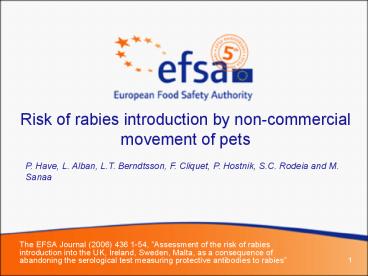Risk of rabies introduction by noncommercial movement of pets - PowerPoint PPT Presentation
1 / 19
Title:
Risk of rabies introduction by noncommercial movement of pets
Description:
Length of waiting period (t) Measured from time of vaccination ... Sample an incubation period (ip) from the lognormal distribution ... – PowerPoint PPT presentation
Number of Views:98
Avg rating:3.0/5.0
Title: Risk of rabies introduction by noncommercial movement of pets
1
Risk of rabies introduction by non-commercial
movement of pets
P. Have, L. Alban, L.T. Berndtsson, F. Cliquet,
P. Hostnik, S.C. Rodeia and M. Sanaa
- The EFSA Journal (2006) 436 1-54, Assessment of
the risk of rabies introduction into the UK,
Ireland, Sweden, Malta, as a consequence of
abandoning the serological test measuring
protective antibodies to rabies
2
Current legislation
- Regulation (EC) No 998/2003
- valid anti-rabies vaccination
- waiting time of at least 21 days (COM 2005/91/EC)
- derogations for UK, Ireland, Sweden and Malta to
maintain serological test - review of derogations at the end of transitory
period of 5 years following receipt of a
scientific opinion of EFSA
3
EFSA mandate
- Commission requested EFSA to issue a scientific
opinion on the risk assessment of rabies
introduction into Ireland, the UK, Sweden and
Malta, as a consequence of abandoning the
serological test for antibody titration for rabies
4
Mandate cont
- To what extent the abandoning of the individual
serological test for neutralising
rabies-antibodies titration could be envisaged
without increasing the risk - If the need to maintain the serological test is
scientifically justified, what is the regime to
be considered as giving equivalent assurance
5
Approach
- Quantitative risk assessment based on
- prevalence of rabies in the country of origin in
pets - distribution of incubation periods of rabies
- efficiency of establishing protective immunity by
vaccination - specificity of the neutralization test for rabies
(RFFIT or FAVN) - length of the waiting period
6
Model parameters
- Prevalence (P)
- estimated from annual incidence data by assuming
a mean incubation time of 38 days - pet population size estimated from 1.0 dog and
1.1 cats per 10 people - P incidence38/(population at risk365)
7
Model parameters
Incubation period
- distribution of incubation periods
- Dogs 1 week to several months
- Cats 9 days to 6 months
- described by a log-normal distribution with mean
38 days
8
Model parameters
- Efficiency of vaccination (Ev)
- assessed indirectly by measuring the antibody
response - measured after first, single vaccination
- absence of antibodies not always associated with
loss of protection - interval between vaccination and testing major
determinant - Ev of 98 used tentatively in this study
9
Model parameters
- Test specificity (Sp)
- determines whether truly antibody-negative
individuals are correctly assigned as such or
whether some individuals are classified as false
positive - FAVN test more specific than RFFIT
- a tentative value of 99 is used here
10
Model parameters
- Length of waiting period (t)
- Measured from time of vaccination
- t will determine the residual prevalence Pa of
animals incubating rabies due to pre-vaccination
exposure
11
Risk pathways
12
Type A risk
13
Type B risk
14
Model descriptionPrevalence A and B
- prevalence Pa of animals already incubating
rabies will gradually decrease as a result of
developing clinical disease - Pa P f(t)
- prevalence Pb of animals infected after the time
of vaccination will gradually replace Pa - Pb P (1- f(t))
15
Model descriptionRisk A and B
- Type A risk
- Type B risk with vaccination
- Type B risk with vaccination and serology
- Ra P f(t) Pa
- Rb (1 - Ev) Pb
- Rb (1 Sp) (1 - Ev) Pb
16
Model descriptionTotal risk
- Total risk Rtot that an animal incubates rabies
at time t after vaccination and serological
testing is given by the sum of Ra and Rb - Rtot P f(t) (1 Sp) (1 - Ev) Pb or
- Rtot P (f(t) (1 Sp) (1 - Ev) (1-
f(t))) or - Rtot P (1 (Ev Sp - Ev Sp )(1- f(t))
17
Model descriptionmodelling f(t)
- Sample an incubation period (ip) from the
lognormal distribution - Sample an interval between infection time and
vaccination (int) from a uniform distribution
between 0 and 365 days prior to vaccination - F(t) calculated from positive values of ip-int
- 100.000 iterations
18
Model descriptionnon-linear least squares
estimate of f(t)
- f(t) exp(-0.0313t)
Rtot P (1 (Ev Sp - Ev Sp )(1-
exp(-0.0313t))
19
Effect of serological testing































